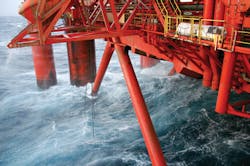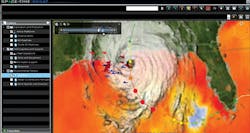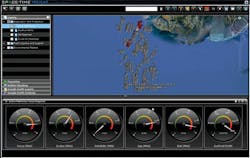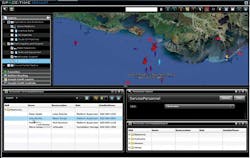Hurricane risk management
Situational intelligence can prevent a crisis from turning into a catastrophe.
Rob Massoudi, Space-Time Insight, Fremont, Calif.
With Tropical Storm Alberto's arrival as the first event in the 2012 Atlantic hurricane season, we are reminded that severe weather can have a devastating impact on the operation of critical infrastructure. This is especially apparent for the offshore oil and gas industry, but also for businesses operating along the Gulf of Mexico coast. However, the petroleum industry is global and thus faces a wide range of threats all over the world.
When a problem arises – whether it's an abnormal sensor reading, communications device failure, or 200-mph winds bearing down on your assets and resources – how quickly and effectively will you be able to respond?
With assets distributed over vast geographies in increasingly unfamiliar and hostile locations, threats from natural disasters and man-made crises abound. Add to that an aging infrastructure with rising failure rates, an aging workforce, commercial systems that don't interface, and proprietary software that is expensive to maintain, and you may be susceptible to missing critical warning signs. With timely and better insight, oil and gas companies can be prepared for the crises that will inevitably impact safety, the environment, production and the bottom line. (See Figure 1).
Fig. 1 -- Prepare for and assess the impact of hurricanes and other crisis conditions on assets and resources.
Every oil and gas company already has the operational and IT data – sensors, alarmed monitors, enterprise applications, weather and geospatial displays, etc. – to avert disasters. However, analysis and orchestration of this disparate data is a manual process prone to error and delays. The challenge is further complicated by the "big data" phenomenon. Making immediate sense of the onslaught of a variety of high-volume, high-speed information is virtually impossible. The resulting slow, inefficient response exposes the company and its resources to business and operational risk.
Situational intelligence at workWhile the imminent storm season calls for a discussion of hurricane risk mitigation, situational intelligence can also be applied to a variety of operational and business activity. This includes:
|
To quickly identify unusual conditions, failures, outages, or resources at risk, and to take corrective action during a crisis like a hurricane, decision makers need to answer a series of questions at the moment these situations arise, or even before they do:
• What is the state of each asset and which ones are at risk?
• Where are my people? The fleet? My field management resources?
• What are the environmental, safety and liability risks?
• What triage is required?
• Who else needs to be notified?
• What can be done to minimize the impact?
Without consistent mechanisms to access, correlate, and gain insight from real-time data in multiple systems, many companies are operating blind. An organization's inability to quickly grasp and react to an unfolding situation means that critical decisions will be delayed, made incorrectly, or simply not made at all—putting assets, lives, the environment, and revenue at risk.
Some large-scale well operators are meeting this challenge head-on with a new approach called situational intelligence.
The where, when and how
The dimensions of space and time are unique in that they are common to all physical phenomena. They also are a natural way for humans to view and absorb multi-faceted situations and events. Instead of searching though text data or spreadsheets, we like to see where and how things are happening, and in what time frame. This is the underlying principle behind situational intelligence.
Situational intelligence software takes advantage of recent advances in complex event processing, big data and multi-dimensional geospatial software to bring data into sharp focus. It melds the fields of computer science, statistics, and analytics, and uses visualization techniques to make data easy to access and understand.
Not every situation represents the same risk. The power of situational intelligence for the oil and gas industry lies in its ability to help key stakeholders analyze the significance of the information being presented, and to prioritize actions and procedures that naturally follow those discoveries. Situational intelligence integrates previously disparate data and correlates it with economic, environmental and external risk factors to guide decision makers through possible courses of action.
The three stages of situational intelligence are visualization, analysis, and action.
Visualize
Various visualization techniques are used in situational intelligence to draw attention to potential problems, including geospatial technology, color-coding, 3-D representations of data, and animation. A geospatial display might, for example, highlight the potential impact of an approaching storm on oil rigs, wells, natural gas and crude oil pipelines, crews, and supply ships. Color coding of assets and resources on the display provides immediate exposure to the assets and resources at risk based on the predicted path of the storm and the current performance measurements of those assets.
Compared to the painstaking process of trying to manually correlate and understand the data from numerous spreadsheets, text documents and screens, situational intelligence accelerates decision-makers' ability to understand a situation and take action to mitigate the impact.
Analyze
The analytics component of situational intelligence plays an important role in helping users to determine the scope, impact and root cause of a problem. (See Figure 2) Users might start with a birds-eye view of all assets in a region, identify (often based on color-coding) which regions need attention, zoom right down to that specific asset, display real-time readings from the asset, and view key performance indicators (KPIs) and other information about that asset. By then exploring a number of different factors, users can determine whether the problem was triggered by sudden drops in temperature or pressure, scheduled maintenance, faulty equipment, damage caused by a hurricane, or any other factor for which data is available.
Fig. 2 -- Visual dashboard showing KPIs such as economic value, reliability, and risk for selected oil rigs.
Familiar analytics dashboard grids and charts also can be bi-directionally linked with geospatial displays. As users navigate around a region on a map, the dashboards change and, conversely, selections in the dashboards are reflected in the map. These analytic capabilities provide additional levels of insight to help operators quickly determine the who, what, when, where, and why of a crisis.
Act
Prompt action is of course essential in a crisis. (See Figure 3) Unfortunately, it relies on a common understanding and knowledge of a situation across multiple teams and systems that are not always available. Situational intelligence focuses on federating data from multiple systems so that all teams involved in a response effort, be they internal or external to a company, can collaborate and make fast, informed decisions.
Fig. 3 -- Performance data, sensor readings, error conditions, and asset information can be correlated in context for easy analysis.
If a disaster occurs, situational intelligence can guide operators through emergency response procedures and help prioritize triage and recovery efforts based on risk, revenue loss, cost, or any other factor. To determine who can get there the fastest to address a problem, an operator can view field crew availability and inventory management systems to identify a replacement part; access GPS systems to display the location of maintenance personnel and helicopters; then refer to the human resources database to narrow down the search to a particular skill set.
Alerts can be set up to notify operators of specific conditions and actions to take when those conditions occur. For instance, a business rule might specify that if wind speed hits 150-mph, the fleet should be notified, personnel should be evacuated, and platforms shut down to avoid a failure or spill. (See Figure 4)
Fig. 4 -- Identify the placement of field personnel, fleet operations, and crisis resources relative to rigs and other assets.
Whether it's infrastructural impact of a severe storm, failure from aging equipment or a host of other environmental, safety or financial issues, oil and gas companies need the ability to anticipate and rapidly respond when threats arise. By quickly transforming data from multiple sources and giving businesses powerful insight into operations, situational intelligence could be the difference between crisis and catastrophe.
About the author
More Oil & Gas Financial Journal Archives Issue Articles
View Oil and Gas Articles on PennEnergy.com





